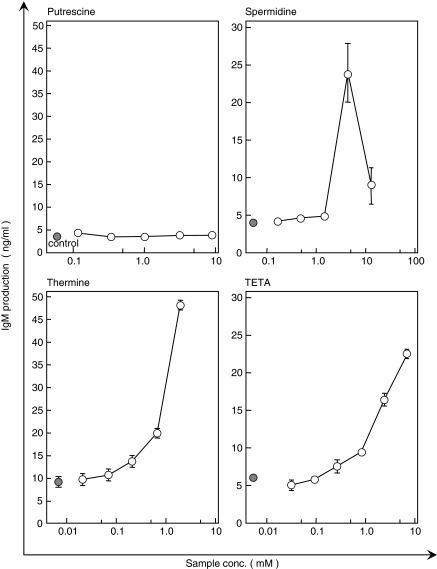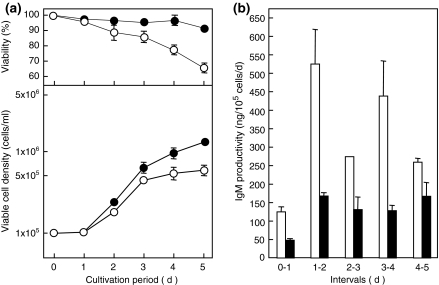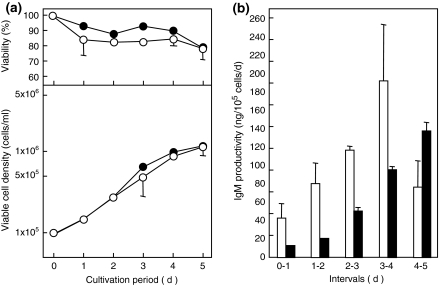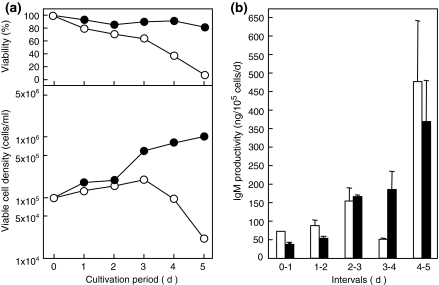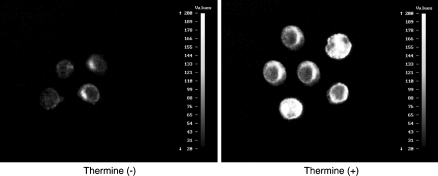Abstract
Immunoglobulin production stimulating activity of polyamines was investigated. Spermidine, thermine and triethylenetetraamine (TETA) stimulated IgM production of human–human hybridoma, HB4C5 cells under serum-free condition. IgM production of HB4C5 cells was accelerated 5.9-, 5.3-, and 3.7-fold by spermidine at 4.5 mM, thermine at 2 mM and TETA at 2.5 mM, respectively. However, putrescine did not enhance IgM production. Spermidine enhanced IgM productivity of the hybridoma cells in spite of its growth suppression activity. TETA also inhibited cell proliferation and the effect on the acceleration of IgM productivity disappeared during 5 days because of its cytotoxicity. On the other hand, thermine facilitated IgM productivity of the hybridoma cells without growth suppression. The laser confocal microscopic analysis revealed that IgM content inside HB4C5 cells was increased by thermine. This result suggests that thermine facilitates IgM synthesis in hybridoma cells.
Keywords: Human–human hybridoma, Immunoglobulin production stimulating factor, Monoclonal antibody, Polyamine, Serum-free culture
Introduction
The complete definition of the cell culture environments is very important for the application of cell culture in industrial fields. However, several challenges are necessary in order to achieve the goal of maintaining functional mammalian cells in totally defined media. The recent development of serum-free media is a requisite for the application of industrial animal cell technology for production of bioactive substances. The advantages of serum-free media compared with those of serum-supplemented media are; (i) the lower cost of the media, (ii) construction of the best physiological conditions depending on each cell line such as growth, production and expression of specific cell functions, and (iii) improvement of downstream processing of culture media (Murakami 1990). In addition, the animal cell culture in serum-free media allows us to produce bioactive substances in extremely high purity, because the serum-free media are free from a large amount of serum components. The serum-free media have been modified to maintain and maximize cellular functions such as growth and productivity. For achievement of efficient production of immunoglobulin (Ig) in the serum-free media, we have screened substances called Ig production stimulating factor (IPSF) that accelerates Ig productivity of hybridomas and lymphocytes. Ig productivity of hybridomas in the serum-free media supplemented with IPSF is superior to that in serum-supplemented media (Murakami et al. 1993). Glyceraldehyde-3-phosphate dehydrogenase (GAPDH) and enolase were purified from Namalwa cell lysate and defined as IPSF (Sugahara et al. 1991, 1992, 1995). Lysozyme and alcohol dehydrogenase-I were also identified as IPSF (Murakami et al. 1997; Sugahara et al. 1997). Lysine-rich histones and poly-lysine also accelerate monoclonal antibody production of human–human hybridoma HB4C5 cells (Maeda et al. 1992; Sugahara et al. 1994; Yamamoto et al. 1995).
On the other hand, improvement of protein-free media is necessary for industrial production of bioactive substances because of the cost and the difficulty of purification, even though serum-free media are employed (Nagira et al. 1995). Then, we focused on low molecular weight substances that stimulate Ig production by human–human hybridoma HB4C5 cells to develop protein-free media. Before screening of low molecular weight IPSF, we paid attention to the common feature of protein IPSFs. As the result, it is revealed that all of protein IPSFs mentioned above are basic proteins or basic poly amino acids. Then, polyamines were investigated as candidates for low molecular weight IPSF. All cells of higher eukaryotes contain significant amounts of the polyamines. Natural polyamines also have a diversity of roles, especially in processes involving nucleic acids, such as DNA replication, transcription and translation (Algranati et al. 1977; Giannakouros et al. 1990; Tabor and Tabor 1976). In addition, we revealed that spermine stimulates IgM production by HB4C5 cells and human peripheral blood lymphocytes (Miyazaki et al. 1998). Here we report the Ig production stimulating effects of polyamines except for spermine on human–human hybridoma HB4C5 cells.
Materials and methods
Polyamines
Polyamines used here were listed in Table 1. Thermine and triethylenetetraamine (TETA) were purchased from Aldrich, USA. Spermidine and putrescine were from Sigma, USA. Polyamines are classified according to the number of amino and imino groups. Putrescine containing 2 amino groups in its structure is categorized in diamines. Spermidine is classified into triamines because it has 1 imino group except for 2 amino groups. In the same way, thermine and TETA containing 2 imino groups are tetraamines. These polyamines were dissolved in 10 mM sodium phosphate buffer (pH 7.4) and neutralized by 6 N HCl before use.
Table 1.
Polyamines
| Polyamine | Structure | M.W. |
|---|---|---|
| Diamines | ||
| Putrescine |  |
88.15 |
| Triamines | ||
| Spermidine |  |
145.25 |
| Tetraamines | ||
| Thermine |  |
188.32 |
| TETA |  |
146.24 |
Cell and cell culture
Human–human hybridoma cell line, HB4C5 cell producing monoclonal IgM was employed to investigate immunoglobulin production stimulating activities of polyamines. HB4C5 cells were cultured in ERDF medium supplemented with 5 μg/mL insulin, 20 μg/mL transferrin, 20 μM ethanolamine and 25 nM sodium selenite (ITES-ERDF) at 37 °C under 5% CO2 in humidified air.
Assay of the IPSF activity
The IPSF activity was analyzed by the measurement of IgM content in ITES-ERDF medium. HB4C5 cells were inoculated at 1 × 105 cells/mL in ITES-ERDF medium supplemented with each polyamine. Cultivation was performed in 24-well culture plate, cultivation volume at 500 μL/well. After cultivation, the cell number was determined using hemocytometer and cell viability was measured by trypan blue dye exclusion test. The amount of IgM in the culture medium was measured by enzyme-linked immunosorbent assay (ELISA) using anti-human IgM (TAGO, USA).
IgM productivity between day 1 (d1) and day 2 (d2) was calculated by the following equation (Merten 1988):
 |
where C1 and C2 are IgM concentrations (ng/mL) in the culture media at day 1 and day 2, respectively. The viable cell densities (cells/mL) at day 1 and day 2 are expressed as X1 and X2.
Analysis of intracellular IgM of HB4C5 cells stimulated by thermine
HB4C5 cells were inoculated at 1 × 105 cells/mL in ITES-ERDF medium with or without 2.0 mM thermine and cultured for 6 h. After cultivation, cells were fixed with 95% ethanol and incubated in phosphate buffered saline (PBS) containing 3% bovine serum albumin (BSA) for 1 h. After washing 3 times with ice-cold PBS, cells were treated with FITC conjugated anti-human IgM antibody (TAGO, USA) in 3% BSA-PBS for 1 h. Then, HB4C5 cells were washed 3 times with PBS and mounted on slides using Permafluor (Immunotech S.A., France) containing 50% glycerol. Fluorescence derived from FITC was determined and visualized using a laser scanning confocal microscope with an argon ion laser coupled with Meridian InSIGHT plus confocal unit attached to Olympus IMT-2 inverted research microscope.
Results
Effects of polyamines on IgM production by HB4C5 cells
Hybridoma HB4C5 cells were cultured for 6 h in ITES-ERDF medium supplemented with each polyamine at various concentrations. The IPSF activity was determined by measuring the amount of IgM in the culture medium by ELISA. As shown in Fig. 1, putrescine, however, did not stimulate IgM production by HB4C5 cells, other polyamines tested here enhanced IgM production of HB4C5 cells in a dose-dependent manner within 6 h after inoculation. Spermidine, a sort of triamines, accelerated Ig production by HB4C5 cells 5.9-fold at 4.5 mM. A rapid drop of the production stimulating activity at high concentration was observed. The reason for this result is the cytotoxicity of polyamines at high concentration. Thermine facilitated IgM production 5.3-fold at 2.0 mM, and TETA also stimulated that of HB4C5 cells 3.7-fold at 7.5 mM.
Fig. 1.
Effects of polyamines on IgM production by HB4C5 cells. HB4C5 cells were inoculated at 1 × 105 cells/mL in ITES-ERDF medium supplemented with putrescine, spermidine, thermine, and TETA at various concentrations. The amount of IgM in culture medium was measured by ELISA. These results are expressed as the mean ± SD of four independent measurements
The structural difference between putrescine and other polyamines is whether they contain imino group or not. Spermidine, thermine and TETA have more than one imino group of which putrescine lacks. This fact suggests that imino groups in polyamines contribute to enhancement of IgM production of HB4C5 cells.
Time-course effect of spermidine on cell growth and IgM productivity of HB4C5 cells
As demonstrated above, spermidine enhanced IgM production. Then the effect of spermidine on growth and IgM productivity of HB4C5 cells was investigated. HB4C5 cells were inoculated at 1.0 × 105 cells/mL and cultured for 5 days in ITES-ERDF medium with or without 4.5 mM spermidine. As shown in Fig. 2a, cell viability of HB4C5 cells was gradually decreased during 5 days by spermidine. However, IgM productivity per 105 cells per day was notably improved by the addition of spermidine as shown in Fig. 2b. The maximum value of the enhancing effect of spermidine on IgM productivity was 3.3-fold, and the average value during 5 days was 2.5-fold. The enhanced productivity was maintained throughout the cultivation period.
Fig. 2.
Effect of spermidine on proliferation and IgM productivity of HB4C5 cells. HB4C5 cells were inoculated at 1 × 105 cells/mL in ITES-ERDF medium supplemented with or without 4.5 mM spermidine and cultured for 5 days. Section (a) shows the growth curves of HB4C5 cells in spermidine-supplemented ITES-ERDF medium (○) and that in ITES-ERDF medium (●). Viable cell density was determined using hemocytometer after trypan blue staining. Section (b) indicates IgM productivity calculated by the formula mentioned in Materials and methods section. The white and black bars express IgM productivity of HB4C5 cells in spermidine-supplemented medium and control medium, respectively. Results are expressed as the mean ± SD of two independent measurements
Time-course effect of thermine on cell growth and IgM productivity of HB4C5 cells
Thermine was examined its effect on cell proliferation and IgM productivity of HB4C5 cells. Thermine was added to the medium at 2.0 mM at which HB4C5 cells can growth. As the result of that, proliferation rate of HB4C5 cells in thermine-supplemented medium was as much as that in control medium, and the viability remained at about 80% (Fig. 3a). IgM productivity was improved during 4 d after inoculation, and the specific productivity rose up to 4.1-fold as demonstrated in Fig. 3b. However, IgM productivity in thermine-supplemented medium at day 5 was lower than that in control medium.
Fig. 3.
Effect of thermine on proliferation and IgM productivity of HB4C5 cells. HB4C5 cells were inoculated at 1 × 105 cells/mL in ITES-ERDF medium supplemented with or without 2.0 mM thermine and cultured for 5 days. Section (a) shows the growth curves of HB4C5 cells in thermine-supplemented ITES-ERDF medium (○) and that in ITES-ERDF medium (●). Section (b) indicates IgM productivity. The white and black bars express IgM productivity of HB4C5 cells in thermine-supplemented medium and control medium, respectively. Results are expressed as the mean ± SD of two independent measurements
Time-course effect of TETA on cell growth and IgM productivity of HB4C5 cells
The effect of TETA on cell proliferation and IgM productivity in ITES-ERDF medium was examined. As indicated in Fig. 1, the optimum concentration of TETA for IgM production during 6 h is 7.5 mM. Preliminary examination showed that HB4C5 cells are not able to multiply at this concentration of TETA because of the cytotoxicity of TETA in a long-term cultivation (data not shown). Then, the lower dose (2.5 mM) was employed for investigation of the time-course effect of TETA on proliferation and IgM productivity of HB4C5 cells during 5 days. The viability of HB4C5 cells cultured in TETA-supplemented ITES-ERDF medium continued to decline after inoculation and finally reached 9.5% as demonstrated in Fig. 4a. Cell growth was also suppressed by TETA and the viable cell density began to decrease after day 3. Though TETA slightly enhanced IgM productivity for 2 days after inoculation, the IgM productivity was decreased along with the decline of cell activity (Fig. 4b).
Fig. 4.
Effect of TETA on proliferation and IgM productivity of HB4C5 cells. HB4C5 cells were inoculated at 1 × 105 cells/mL in ITES-ERDF medium supplemented with or without 2.5 mM TETA, and cultured for 5 days. Section (a) shows the growth curves of HB4C5 cells in TETA-supplemented ITES-ERDF medium (○) and that in ITES-ERDF medium (●). Section (b) indicates IgM productivity of HB4C5 cells. The white and black bars express IgM productivity of HB4C5 cells in TETA-supplemented medium and control medium, respectively. Results are expressed as the mean ± SD of two independent measurements
Intracellular IgM of HB4C5 cells treated with thermine
As demonstrated above, it is expected that thermine is the most effective IPSF among polyamines tested here. Then, the IgM content in HB4C5 cells stimulated by thermine was investigated. HB4C5 cells were cultured for 6 h in ITES-ERDF medium supplemented with or without 2.0 mM thermine. After cultivation, these cells were fixed with 95% ethanol, and intracellular IgM was labeled with FITC-conjugated anti-human IgM antibody. Then the samples were visualized using a laser scanning confocal microscope with an argon ion laser. As shown in Fig. 5, the fluorescence intensity of thermine-treated cells was stronger than that of control cells. This result clearly demonstrates that the amount of intracellular IgM is increased by the addition of thermine in the medium. It is supposed from these findings that thermine enhances IgM productivity by acceleration of IgM synthesis in HB4C5 cells.
Fig. 5.
Intracellular IgM of HB4C5 cells treated with thermine HB4C5 cells were inoculated at 1 × 106 cells/mL in ITES-ERDF medium containing 2.0 mM thermine or not, and cultured for 6 h. After cultivation, intracellular IgM was labeled by anti-human IgM antibodies conjugated with FITC. Fluorescence intensity was observed by an argon ion laser scanning confocal microscope in same condition
Discussion
Low Ig productivity of hybridomas in serum-free medium compared with that in serum-supplemented medium prompted us to screen Ig production stimulating factors. In this report, we focused on polyamines as candidates for IPSF because of the following three reasons. The first point is the basicity of polyamines, because most of protein IPSFs are basic proteins or basic poly amino acids. Secondly, polyamines have several important biological functions, such as stabilizing DNA folding (Flink and Pettijohn 1975), binding affinity for synthetic polynucleotide (Igarashi et al. 1977), and stimulation of proliferation and differentiation of cells (Pegg and McCann 1982). Moreover, polyamine analogs enhance protein and polypeptides synthesis (Tabor and Tabor 1976; Kakegawa et al. 1988; Friedman and Oshima 1989). Finally, low molecular weight IPSF is indispensable to develop serum-free and protein-free media for efficient production of monoclonal antibody. Productivity of animal cells in serum-free or protein-free media is inferior to that in serum-supplemented media as a general (Murakami et al. 1993). Therefore, low molecular weight non-protein IPSF is necessary for improvement of the high-productivity media without serum.
As the result of short-term assay of IPSF activities of polyamines, spermidine, thermine, and TETA stimulated IgM production of HB4C5 cells 5.9-, 5.3-, and 3.7-fold, respectively. However, putrescine was inefficient in accelerating IgM production, even though the structural feature is very similar to those of other polyamines. Table 1 shows that putrescine is categorized in diamines that have no imino groups in their structures. It may be that imino groups in polyamines are concerned with enhancement of IgM production by HB4C5 cells. There is room for further investigation about the correlation between IPSF activity and imino groups in polyamines. Moreover, IPSF activities of other amines, such as catecholamines, phenolamines, indoleamines, and imidazoleamines were investigated. The result showed that these amines except for polyamines did not facilitate IgM production by HB4C5 cells (data not shown). This fact suggests that the linear structure also participates in expression of the IPSF effect of polyamines.
The effects of spermidine, thermine, and TETA on cell proliferation and IgM productivity were tested. As the result of that, TETA was not suitable for cell growth and enhancement of IgM productivity for long period. In marked contrast to TETA, thermine enhanced IgM productivity of HB4C5 cells without cytotoxicity at 2.0 mM, even though both TETA and thermine are tetraamines and the structural features between them is very close. The correlation between structures of polyamines and their IPSF activities is uncovered yet. The result indicates that thermine is an appropriate IPSF for high-productivity serum-free and protein-free media. The quantitative analysis of intracellular IgM using the laser confocal microscope revealed that thermine accelerated cellular productivity of monoclonal antibody. This fact suggests that thermine facilitates protein synthesis activity of the hybridoma cell. The effect of thermine on protein synthesis processes, such as transcription and translation, is now under investigation. The results from these data, thermine acts at low concentration, it may be able to be carried out as the available production enhancer of the IgM using HB4C5 cells at low cost.
Abbreviations
- BSA
Bovine serum albumin
- ELISA
Enzyme-linked immunosorbent assay
- FITC
Fluorescein isothiocyanate
- GAPDH
Glyceraldehyde-3-phosphate dehydrogenase
- Ig
Immunoglobulin
- IPSF
Immunoglobulin production stimulating factor
- PBS
Phosphate buffered saline
- TETA
Triethylenetetraamine
References
- Algranati ID, Goldemberg SH (1977) Polyamines and their role in protein synthesis. Trends Biochem Sci 2:272–274 [DOI]
- Flink I, Pettijohn DE (1975) Polyamines stabilize DNA folds. Nature 253:62–63 [DOI] [PubMed]
- Friedman SM, Oshima T (1989) Polyamines of sulfur-dependent archaebacteria and their role in protein synthesis. J Biochem 105:1030–1033 [DOI] [PubMed]
- Giannakouros T, Nikolakaki H, Georgatsos JG (1990) Concentration-dependent effects of natural polyamines on peptide chain initiation and elongation in a cell-free system of protein synthesis. Mol Cell Biochem 99:9–19 [DOI] [PubMed]
- Igarashi K, Aoki Y, Hiroshe S (1977) Base specificity of polyamine binding to synthetic polynucleotides. J Biochem 81:1091–1096 [DOI] [PubMed]
- Kakegawa T, Takamiya K, Ogawa T, Hayashi Y, Hirose S, Niitsu M, Samejima K, Igarashi K (1988) Effect of various polyamine analogs on in vitro polypeptide synthesis. Arch Biochem Biophys 261:250–256 [DOI] [PubMed]
- Maeda M, Murakami H, Ohta H, Tajima M (1992) Stimulation of IgM production in human–human hybridoma HB4C5 cells by chitosan. Biosci Biotechnol Biochem 56:427–431 [DOI] [PubMed]
- Merten O-W (1988) Batch production and growth kinetics of hybridomas. Cytotechnology 1:113–121 [DOI] [PubMed]
- Miyazaki Y, Nishimoto S, Sasaki T, Sugahara T (1998) Spermine enhances IgM productivity of human–human hybridoma HB4C5 cells and human peripheral blood lymphocytes. Cytotechnology 26:111–118 [DOI] [PMC free article] [PubMed]
- Murakami F, Sasaki T, Sugahara T (1997) Lysozyme stimulates immunoglobulin production by human–human hybridoma and human peripheral blood lymphocytes. Cytotechnology 24:177–182 [DOI] [PMC free article] [PubMed]
- Murakami H (1990) What should be focused in the study of cell culture technology for production of bioactive proteins. Cytotechnology 3:3–7 [DOI] [PubMed]
- Murakami H, Sugahara T, Nakajima H (1993) Immunoglobulin production stimulating factors. In: Oka MS, Rupp RG (eds) Cell biology and biotechnology: novel approaches to increased cellular productivity. Springer-Verlag New York, Inc., USA, pp 35–62
- Nagira K, Hara T, Hayashida M, Osada K, Shiga M, Sasamoto K, Kina K, Murakami H (1995) Development of a protein-free medium with iron salts replacing transferrin for a human–human hybridoma. Biosci Biotechnol Biochem 59:743–745 [DOI] [PubMed]
- Pegg AE, McCann PP (1982) Polyamine metabolism and function. Cell Physiol 12:212–221 [DOI] [PubMed]
- Sugahara T, Shirahata S, Akiyoshi K, Isobe T, Okuyama T, Murakami H (1991) Immunoglobulin production stimulating factor-IIa (IPSF-IIa) is glyceraldehyde-3-phosphate dehydrogenase like protein. Cytotechnology 6:115–120 [DOI] [PubMed]
- Sugahara T, Nakajima H, Shirahata S, Murakami H (1992) Purification and characterization of immunoglobulin production stimulating factor-IIb derived from Namalwa cells. Cytotechnology 10:137–146 [DOI] [PubMed]
- Sugahara T, Sasaki T, Murakami H (1994) Enhancement of immunoglobulin productivity of human–human hybridoma HB4C5 cells by basic proteins and poly-basic amino acids. Biosci Biotechnol Biochem 58:2212–2214 [DOI] [PubMed]
- Sugahara T, Shirahata S, Sasaki T, Murakami H (1995) The mode of actions of glyceraldehyde-3-phosphate dehydrogenase identified as an immunoglobulin production stimulating factor. FEBS Lett 368:92–96 [DOI] [PubMed]
- Sugahara T, Furutani H, Sasaki T (1997) Alcohol dehydrogenase-I from horse liver stimulates immunoglobulin production by human hybridoma and human peripheral blood lymphocytes. Mol Cell Biochem 173:133–119 [DOI] [PubMed]
- Tabor CW, Tabor H (1976) 1,4-diaminobutane (putrescine), spermidine, and spermine. Annu Rev Biochem 45:285–306 [DOI] [PubMed]
- Yamamoto MM, Mori Y, Osada K, Murakami H (1995) Enhancement of production of IgM and interferon-b in human cell lines by poly-lysine. Biosci Biotechnol Biochem 59:1842–1845 [DOI] [PubMed]



